 For the last few week’s I’ve been using Vodafone Australia’s new 4G network, and I must say it ain’t bad at all. Here’s quite a long post about what I’ve experienced.
For the last few week’s I’ve been using Vodafone Australia’s new 4G network, and I must say it ain’t bad at all. Here’s quite a long post about what I’ve experienced.
Since Saturday 8 June 2013 — that is, since about a week before the network was launched to the public — I’ve used Vodafone’s network as my primary data link to the internet, via a Samsung Galaxy S IV 4G handset that Vodafone loaned me, along with a SIM that gave me uncapped data. Generally I used that smartphone as a Wi-Fi hotspot for my everyday internet use.
Normally I use Telstra’s Next G 4G network — or their 3G network outside 4G coverage areas. The hardware is either a Sierra Wireless pocket Wi-Fi hotspot, or sometimes my Samsung Galaxy S III 4G handset configured as a Wi-Fi hotspot. So what you’re about to read is, I think, a reasonable comparison.
That said, I’d call this a “trial”, not a “test”. I was not rigorous at all about this, and the results only reflect what I experienced on the days in question. Your mileage may vary.
Key Observations
- I often work on the train between Sydney and the Blue Mountains. So, on Saturday 8 June, I did a side-by-side comparison. With all other data usage removed from the handsets, I did speed tests as speedtest.net as they sat on my lap. On the train. The detailed results are over the fold. As you’ll see, Vodafone’s network was often faster than Telstra’s, especially where Telstra was likely to suffer congestion. This is unsurprising: there weren’t any customers on Vodafone’s network yet.
- Over the three weeks of the trial, my general impression was that where both Vodafone and Telstra had 4G coverage, they offered similar speeds. In highly congested locations, such as the Sydney CBD, North Sydney or Newtown, Vodafone often pulled ahead. But Vodafone obviously has far less geographic coverage for now. See below for the maps.
- Up at my Blue Mountains base near Wentworth Falls, neither Vodafone nor Telstra had 4G coverage, only 3G. While I didn’t do speed tests there, as a user I found no noticeable difference between the two networks. That is, there were no occasions when I felt the urge to whinge that Vodafone’s network was causing me more problems that Telstra’s usually did. Both seemed to have the same difficulty punching a signal through a eucalypt forest that’s waving in the wind. That’s not Science, obviously, but it says… something. Probably that there’s not much to choose between the two networks in that location, given the sort of things I do.
- On my regular train runs up and down the mountains, there was no real experiential difference between Vodafone’s network and Telstra’s — except, of course, where Vodafone has no 4G. Apart from one factor, that is. My impression was that the Telstra handset was better at noticing when 4G became available and switching to that, whereas the one on Vodafone would stay on 3G all the way into Central even though there’s plenty of 4G areas — but I didn’t test this properly.
- Using mobile broadband is a very different experience when you’re not worried about how many gigabytes of data you’re sucking down. As I wrote the other week, the promise of mobile broadband is years away.
Overall, it would appear that Vodafone is rolling out a 4G network that will match Telstra’s in terms of performance, at least once the coverage is in place. Assuming there’s coverage where you need it, the choice will come down to the pricing and support, as always. Whether this will be enough for Vodafone to win back the customers they’ve lost is another question.
Here are the results of the speed tests done 8 June 2013. In all of these, Vodafone is shown on the left, Telstra on the right.
Speed Test 1: Railway Square, Sydney
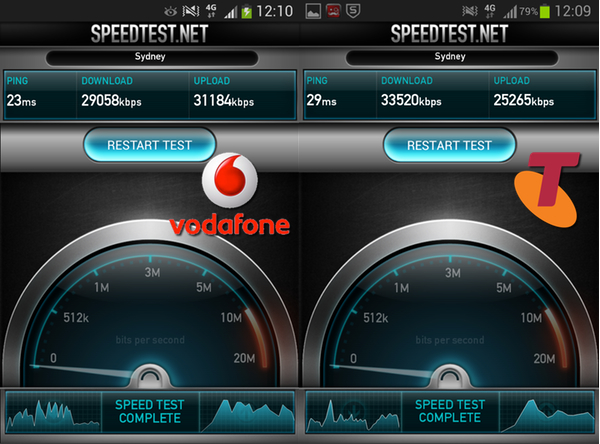
Railway Square wasn’t quite as busy as a weekday, but there were still plenty of people around. Vodafone’s 29.1 Mbps download speed almost matched Telstra’s 33.5 Mbps. I was pleased to see that Vodafone’s 31.2 Mbps upload speed beat Telstra’s 25.3 Mbps.
That said, the speed on both networks varied a lot over the short time I was playing with them. And I was inside a pub. Of course.
Speed Test 2: Sydney Central station
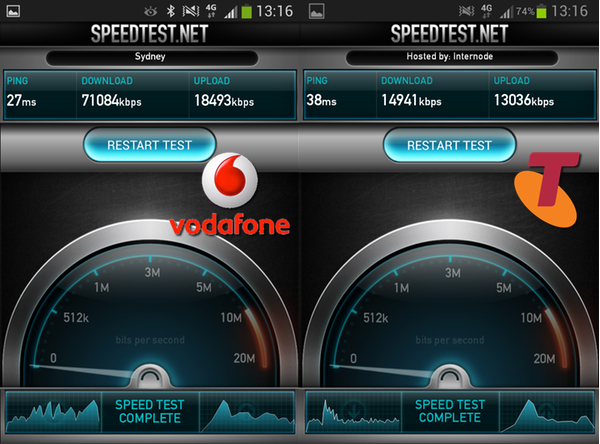
This test was done inside the train as it sat on platform 12. Vodafone’s 71.1 Mbps download speed made Telstra’s 14.9 Mbps look embarrassing. Vodafone’s upload speed of 18.5 Mbps was also well ahead of Telstra’s 13 Mbps.
Speed Test 3: Strathfield station
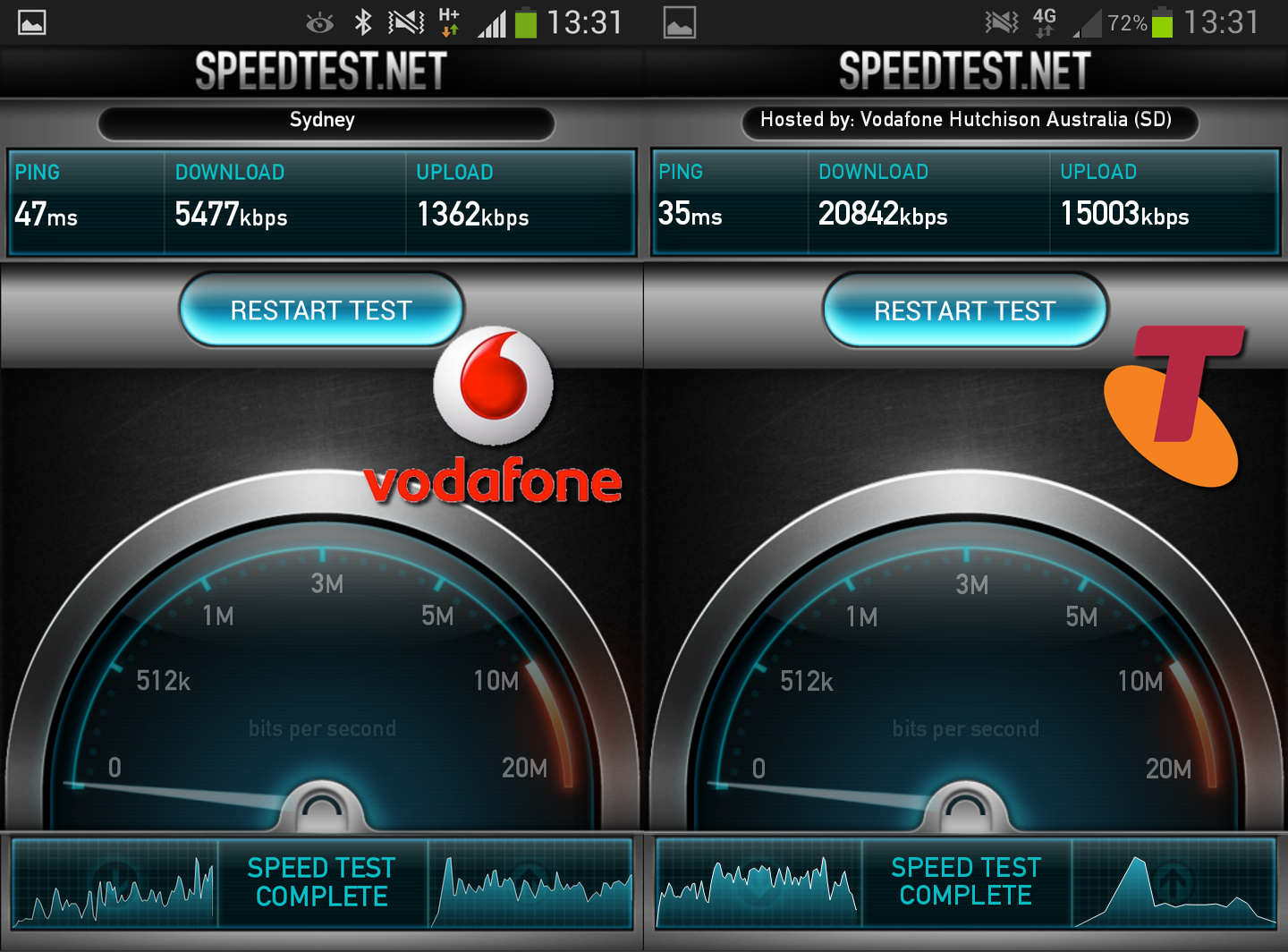
So here’s what happens when you leave Vodafone’s 4G network. The speed drops back to 5.5 Mbps down and 1.4 Mbps up, compared with Telstra’s 4G speed of 20.8 Mbps down and 15 Mbps up.
This test was done as the station stood at the platform, but the train had only been stationary for maybe 10 or 15 seconds, so I’m not sure if that’s long enough for it to find the best cell tower to use.
You can see the difference between Vodafone and Telstra’s coverage at Strathfield when you look at the maps.
First, here’s Vodafone’s coverage of Western Sydney (below), with 4G areas marked with the darker of the two purples. The darkest colour, the blue, is actually 3G. If you look around Strathfield there’s a jumble of 3G and 4G reception areas, and obviously we got 3G on the day. You can click through for the interactive map.
By comparison, the Telstra map (below) uses the darkest blue to show 4G areas, and there’s almost solid coverage right through the Inner West. Again, you can click through for the interactive map.
I’ll be interested to see how Vodafone’s network performs when the 4G coverage isn’t quite such a patchwork.
Speed Test 4: Granville station
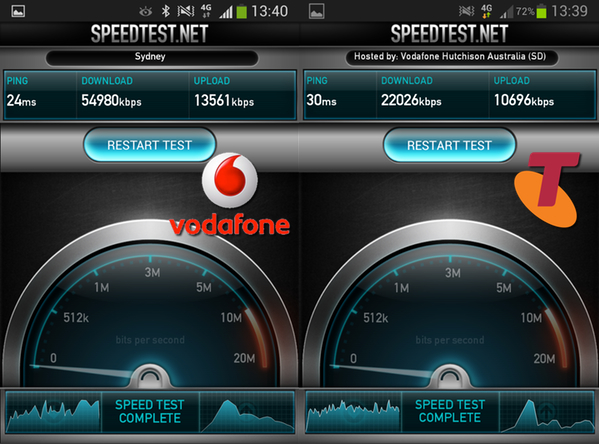
Standing at Granville station, Vodafone found its 4G again, testing at 55 Mbps down and 13.6 Mbps up, compared with Telstra’s 22Mbps down and 10.7 Mbps up. Not too shabby.
Speed Test 5: Emu Plains
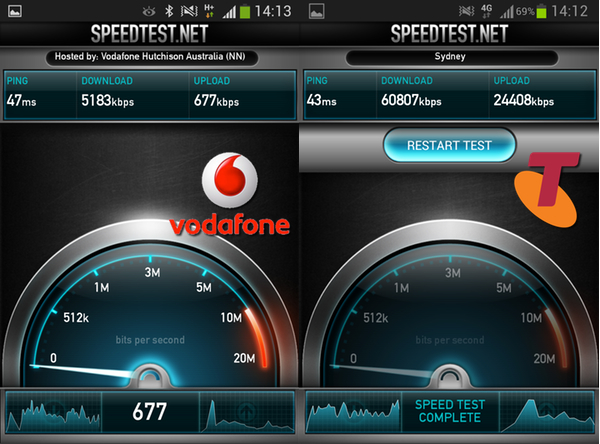
If memory serves me correctly, the final test was done from the moving train as it climbed the hill up past Emu Plains towards the Blue Mountains. Vodafone has dropped back to 3G, with speeds or 5.2 Mbps down and 0.68 Mbps up, while Telstra maintains a 4G link with speeds of 60.8 Mbps down and 24.4 Mbps up.
Again, I must stress that this a “trial”, not a “test”. The results are merely what I experienced on the days in question. Your mileage may vary.
[Note: As I publish this post, I see that the “Possibly Related Post” list below includes some headlines that reflect poorly on Vodafone. They’re from a long time ago, and Vodafone Australia has been through one hell of a management purge since then.]

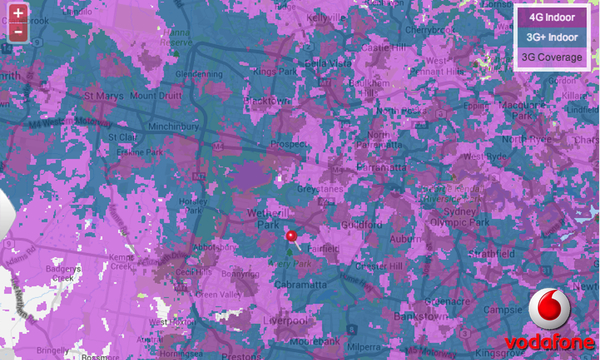
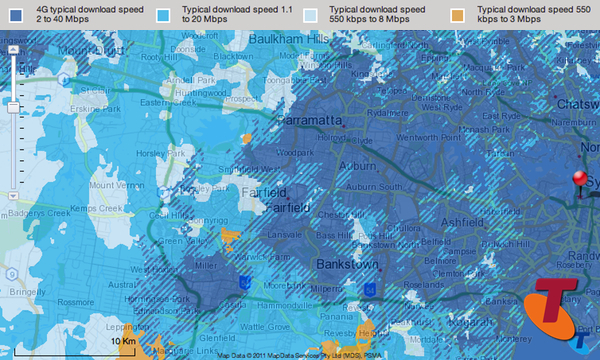
How was the Samsung 4S? Is it worth getting the non-skinned google play version instead?
@Brian, yes. Go forth and purchase. You have my approval.
@Brian: To be honest, I’m not the best person to ask. I don’t actively explore the different versions of Android, and once I start using a particular platform I tend to stick with it. I just treat them as tools to do a job and prefer to stay a notch back from the bleeding edge.
Indeed, I switched from Nokia Simbian to Android because I was given an HTC Desire around the time my last Nokia died. Then when the Desire was on its last legs, I was given a Samsung Galaxy S III. When I dropped that phone onto concrete and buggered it, I just got another one on contract from Telstra because it was what I was used to using — except I got the 4G version.
Finally, as the Samsung Galaxy S IV was a loaner unit, I didn’t really explore it — except to note that there were various minor improvements to the interface.
I haven’t ever used a stock Google Android. Maybe Google should fix that.
“I haven’t ever used a stock Google Android. Maybe Google should fix that.”
@Stilgherrian, Google have already fixed that. They create their own devices under the name “Nexus” which ships with stock Google Android. @Brian, The Samsung GS4 is worth the coin. Holla back if you’d like me to demo it live to you over webcam. I promise nothing from my chin down will be revealed.
@bacaren: Oh, I meant “maybe Google should fix that” in the sense that they might like to give me an evaluation unit. Or lend me one. But that said, this is way down my priority list, so it’s reasonable for it to be way down theirs too.